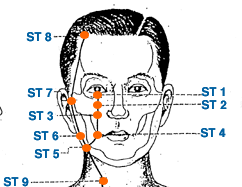ST 1 ST1 Tear Container Chengqi 承泣 stomach 1 Stomach 1 st1
Back to meridian
ST 1 ST1
ST 1 ST1
ST 1 Tear Container - Chengqi - 承泣

Location
Below the pupil, between the eyeball and the infraorbital ridge.
Actions
- Any eye issue, although ST 2 is a good alternative and arguably safer to needle.
- Excessive lacrimation, redness, dryness, painful a/or itchy eyes/eyelids, twitching of the eyelids.
- Visual disturbances, night blindness.
ST 1 Cautions
Precautions:
- No Moxa (MX): Cautions with moxa.
- General (X): General precautions.
Additional Cautions:
Slow insertion, no manipulation.
For a more comprehensive list of all cautions, see our precautions and contraindications page.
Back to meridian
